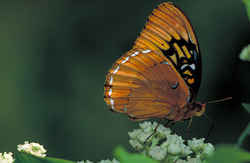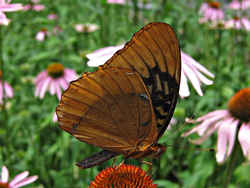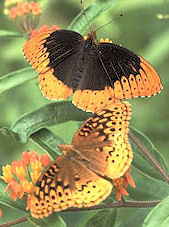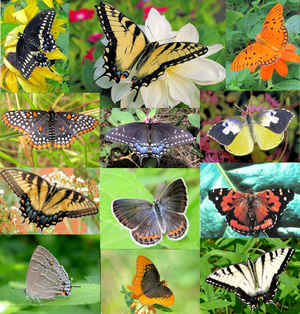
Arkansas Symbols
Arkansas State Butterfly
Diana fritillary butterfly

(Speyeria diana)
Adopted on February 28, 2007.
On February 28, 2007, Act 156 of the Arkansas General Assembly designated the Diana fritillary, (Speyeria diana,) as the official
state butterfly. Introduced by Representative John Paul Wells of Logan County, the legislation for making the butterfly a state symbol took note of
the butterfly's beauty, educational importance, and impact on tourism in Arkansas.
Arkansas is the only state to designate the Diana fritillary as its state butterfly, pairing it with its state insect, the
honeybee. Arkansas is the twenty-sixth state to designate a butterfly as a state symbol.
Arkansas State Butterfly: Diana Fritillary Butterfly

In 2007, the Diana Fritillary became the official state butterfly. These butterflies are large and beautiful with a wingspan of about 3.5"and bright colors on their spotted wings. Males are dark brown with orange markings. The larger females are black with bright blue markings and white spots. Diana Fritillary butterflies live in the moist mountain areas of Arkansas and feed on the nectar of flowers. Mount Magazine is one of the best locations to see them during the summer.
Characteristics of the Diana Fritillary Butterfly
The Diana Fritillary is a dimorphic butterfly found in several wooded areas in southern and eastern North America (primarily in the Arkansas River valley, several counties in South Carolina, and spots along the Appalachian mountain range). Males of the species exhibit an orange color on the edges of their wings, with a burnt orange under-wing which does not have the typical silver scales found in most fritillary species. The female is dark blue, with dark, almost dusty under-wings and is much larger than the male

This species is a specialist of forested areas, in contrast to most other eastern members of the genus, which are usually found in more open areas.
The Diana fritillary and its congeners feed on violets (Viola spp.) as larvae, with S. diana feeding on several woodland species. Larvae emerge
from eggs laid on the ground in the fall. They overwinter as first instars, very young juveniles; insects typically mature at or near instar five.
They begin feeding in the spring and complete development by late spring. They then pupate in the leaf litter, undergo metamorphosis and emerge as
adults, generally starting in June. Males are typically the first to emerge, with females following one-and-a-half to two weeks later. During the first
part of the summer, males are almost exclusively seen at flowers and actively flying through the habitat. Females become much more apparent later in
the summer, starting in late July as they spend more time searching
for oviposition sites.
Arkansas Law
The law designating the Diana fritillary butterfly as the official Arkansas state butterfly is found in the Arkansas Code (Non annotated), Title
1, Chapter 4. Title 1 General Provisions Chapter 4 State Symbols, Motto, Etc., Section 1-4-126.
Arkansas Code (Non annotated)
Title 1 General Provisions
Chapter 4 State Symbols, Motto, Etc.
1-4-126.State butterfly.
The Diana fritillary butterfly is designated the official butterfly of the State of Arkansas.
History. Acts 2007, No. 156, § 1.
Taxonomic Hierarchy: Diana Fritillary Butterfly
Kingdom: Animalia (Animals)Phylum: Arthropoda (Arthropods)
Subphylum: Hexapoda (Hexapods)
Class; Insecta (Insects)
Order; Lepidoptera (Butterflies and Moths)
Superfamily: Papilionoidea (Butterflies and Skippers)
Family: Nymphalidae (Brush-footed Butterflies)
Subfamily: Heliconiinae (Heliconians and Fritillaries)
Tribe: Argynnini (Fritillaries)
Genus: Speyeria (Greater Fritillaries)
Species; diana (Diana fritillary)
Butterflies, and Bugs







